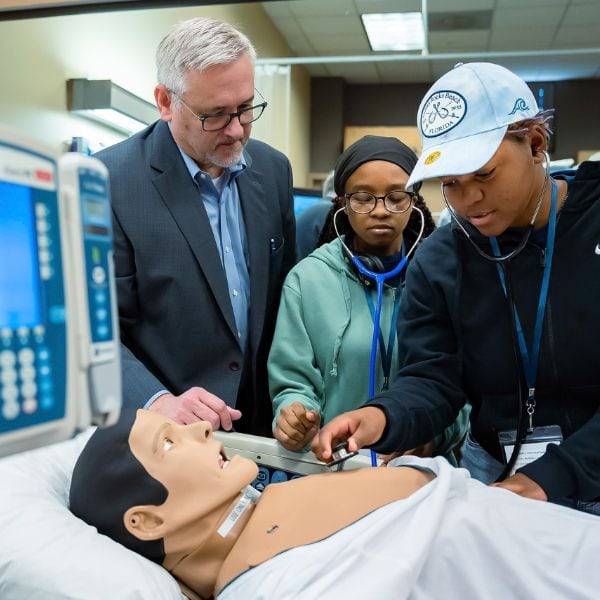BridgeYear
A OneGoal partner, BridgeYear in Texas connects students to careers and educational opportunities through their Career Test Drive experience and one-on-one postsecondary advising.
Non-degree education opportunities after high school through progressive pathways could lead to promising careers or provide a stepping stone to a degree pathway.
For decades, continuing your education after high school in the United States has meant applying for a seat at either a two- or four-year college or university. High school seniors weren’t often encouraged to consider trade, vocational, or workforce development programs, which carried the stigma of a “backup plan” for students perceived as unwilling or unable to attend college.
But with shifts in the economy and the rise of certification opportunities for high-wage positions in healthcare, tech, manufacturing, service industry, and other sectors, attitudes about these pathways are changing, and many students are considering non-degree opportunities to achieve their career goals.
Studies show that two- and four-year degrees from colleges and universities can open doors to many career paths and higher earnings. But not every student will thrive in these environments or find the courses necessary for their chosen career path within these institutions. Students who are more interested in a career that does not require a bachelor’s degree might want to consider a Progressive Pathway.
Progressive Pathways, or ProPaths, refer to education pathways after high school that are high-value, non-degree credentials, certifications, licenses, and apprenticeships that employers value. ProPaths are designed to offer students a more direct and focused approach to developing skills and knowledge for specific industries or careers, often through vocational or trade schools, certificate programs, apprenticeships, and other non-degree programs. These credentials can often be “stacked” with additional education and training that leads to more advanced certifications and degrees with higher-wage career opportunities.
Career and Technical Education (CTE) programs offered by community colleges and vocational or trade schools share similarities in their focus on practical skills and career preparation. However, there are a few key differences between the two.

Progressive pathways offer certification opportunities for high-wage positions in fields such as healthcare.
Community colleges are usually public institutions offering a variety of academic programs, including CTE programs. They are accredited and often have a broader range of educational opportunities, like certification programs, associate degrees, and transferable credits to four-year colleges and universities.
Most vocational or trade schools, on the other hand, are private institutions that specialize in career-focused education. They may offer shorter-term programs, such as certificates or credentials focused solely on specific job skills. Accreditation for trade schools varies, and they may only offer industry-specific specialized accreditation.
CTE programs at community colleges usually range from one to two years in duration, leading to a certificate or associate degree. These programs often provide a broader educational foundation in addition to specialized vocational training. Community colleges may also offer options for students to transfer their credits to pursue higher education if they choose to do so.
Vocational or trade schools typically offer shorter programs that can be completed in a matter of months to one year. These programs focus on developing the skills needed for a particular trade or occupation. Trade schools do not emphasize general education courses but instead concentrate on practical training for immediate job entry.
The cost of CTE programs at community colleges can vary depending on factors such as residency, program length, and specific fees. However, community colleges are generally more affordable than four-year colleges and universities. They also often offer financial aid options, scholarships, and grants to eligible students, making education more accessible.
Vocational or trade schools tend to be more expensive than community colleges due to their specialized nature and often being private institutions. Financial aid options, like those offered by the Workforce Innovation and Opportunity Act (WIOA) may be available. Still, they may differ from those offered by community colleges, and students should research the specific options provided by the trade school they are considering.
There are several non-degree pathways for students after high school facilitated by community-based nonprofit organizations. These programs aim to provide young individuals with alternative education and career development opportunities to help them succeed in the workforce. Some notable examples include:
A OneGoal partner, BridgeYear in Texas connects students to careers and educational opportunities through their Career Test Drive experience and one-on-one postsecondary advising.
A OneGoal national partner, Year Up is a one-year intensive program that combines hands-on skill training with professional internships. It targets young adults aged 18 to 24, equipping them with technical and professional skills that align with market demands. Year Up often partners with companies to provide internship opportunities for their participants.
This organization offers a range of service opportunities for individuals over 18, including high school graduates. Through AmeriCorps, students can engage in community service projects, gain valuable work experience, and earn education awards to help pay for college or pay off student loans.
This national service organization that recruits young adults to serve as mentors and tutors in schools with high needs. City Year participants work with students to improve their educational outcomes and develop leadership and teamwork skills.
This free education and training program is for young adults aged 16 to 24. Job Corps offers a wide range of vocational and academic programs, helping participants acquire the skills needed to secure meaningful employment.
These community college, trade/vocational school, and nonprofit and governmental organizations and programs can be excellent options for students who want to explore pathways after high school outside of the two- and four-year degree paths, gain valuable skills, and pursue meaningful careers.
Shelby Ward was born and raised in Spokane, Washington. She received her BA in history teaching from Brigham Young University in Provo, Utah, where she had the opportunity to move to Houston for a three-month internship. Despite experiencing her first hurricane 10 days after moving in, Shelby never left and is now a OneGoal Program Director in Texas.

Sifting through postsecondary options can be overwhelming for students. The Quality Enrollment Framework at OneGoal supports students in narrowing these options into a shortened “best fit” list.
Students pursuing careers in healthcare or other skilled trades are exploring alternatives to two- and four-year college. OneGoal Fellow Makayla Ransom sees vocational school as a stepping stone in her education and career journey.
Mercy Ajala’s dream of flying has guided her postsecondary journey into aviation school and flight training. With one semester left of her postsecondary education, Mercy reflects on her relentless pursuit of becoming a pilot.